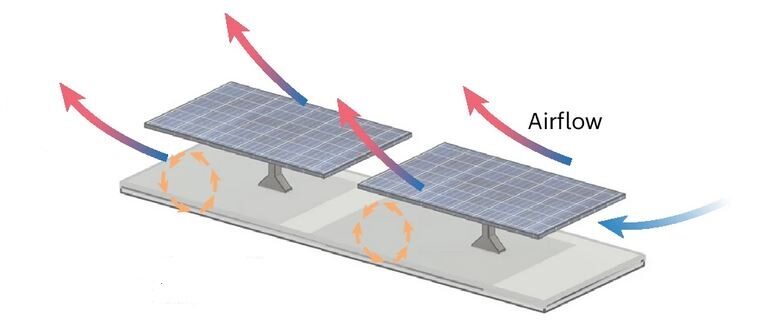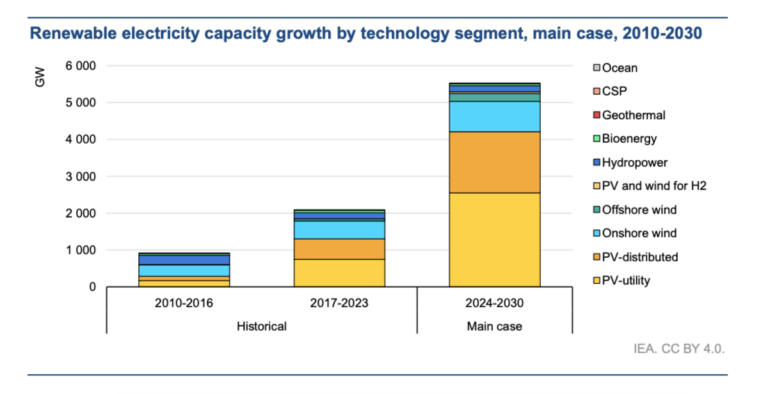The International Energy Agency says renewables are on track to meet almost half of global electricity demand by 2030, with solar accounting for 80% of capacity growth.
The International Energy Agency (IEA) predicts that more than 4,000 GW of new solar energy will be added worldwide by the end of the decade.
The agency’s flagship report: “Renewable energy sources 2024,” says the world will add more than 5,500 GW of new renewable energy capacity between 2024 and 2030, to reach a cumulative capacity of almost 11,000 GW.
The forecast indicates that solar energy will account for 80% of renewable energy growth over the next six years. Utility-scale solar will account for the majority of solar expansion, but distributed applications, which include residential, commercial, industrial and off-grid projects, are expected to account for nearly 40% of new solar make up energy.
“Adoption is accelerating due to falling costs, shorter licensing times and widespread social acceptance,” the report said. “Cost competitiveness and policy support are also driving the growth of distributed applications among residential and commercial consumers as more households and businesses seek to reduce their electricity bills.”
The report adds that the global expansion of renewable capacity will continue to increase every year, reaching almost 940 GW per year by 2030.
Image: IEA
China is expected to remain the dominant player in the global market and is expected to account for 60% of the expansion of global renewable energy capacity by 2030. The European Union and the United States are both expected to double their pace of renewable energy capacity growth between 2024 and 2024. 2030, with the EU’s ambition for 600 GW of solar power “within reach” by the end of this decade, the report said.
India has the fastest growth in renewables among major economies, the IEA says, which it attributes to the rapid expansion of the number of auctions in the country, the introduction of a new support program for rooftop solar and stronger financial indicators.
The IEA adds that the largely untapped potential of renewable energy sources in emerging and developing economies can be realized if policies improve. The IEA explains that high financing costs continue to reduce the economic attractiveness of renewables in these markets. Weak network infrastructure, developing economies and integrate safely renewable energy sources are mentioned as other key challenges
“Measures to reduce risks, including by creating stable policy environments with clear long-term goals, can help unlock additional capacity,” the report said. “In countries with excess fossil fuel capacity with long-term contracts, policymakers may consider renegotiating inflexible energy and fuel contracts and accelerating the phase-out of fossil fuel plants.”
While the overall growth is not fully in line with the COP28 target of tripling the world’s renewable capacity this decade, but instead represents 2.7 times growth, the IEA says its analysis indicates that Fully achieving the tripling target is possible if governments seize short-term opportunities for action.
It calls on countries to announce greater ambitions in the next round of Nationally Determined Contributions (NDC), due in 2025. Only 14 countries had explicit renewable capacity targets in the NDCs designed before COP28, but the report found that nearly 70 countries, which together account for 80% of global renewable energy capacity, are ready to achieve or exceed their current 2030 renewable ambitions.
“This report shows that the growth of renewable energy sources, especially solar energy, will transform electricity systems around the world this decade,” said Fatih Birol, executive director of the IEA. “Renewable energy sources are developing faster than national governments can set targets. In particular, this is not just driven by efforts to reduce emissions or increase energy security – it is increasingly because renewables now offer the cheapest option for adding new power plants in almost all countries around the world.”
This content is copyrighted and may not be reused. If you would like to collaborate with us and reuse some of our content, please contact: editors@pv-magazine.com.
Popular content



